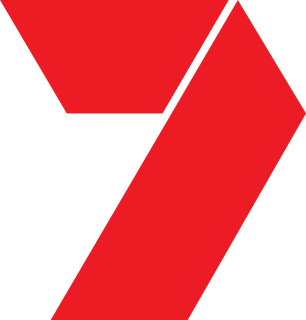The Australian Broadcasting Corporation (ABC) is Australia's national broadcaster. It is principally funded by the direct grants from the Australian Government, and is administered by a board appointed by the government of the day. The ABC is a publicly owned and funded body that is politically independent and fully accountable, with its charter enshrined in legislation, the Australian Broadcasting Corporation Act 1983.

The Nine Network is a major Australian commercial free-to-air television network. The network's headquarters are located in Sydney and it is one of five main free-to-air networks in Australia. It is owned by Nine Entertainment Co.

Network 10 is an Australian commercial television network. One of five national free-to-air networks, 10's owned-and-operated stations can be found in the state capital cities of Sydney, Melbourne, Brisbane, Adelaide and Perth while affiliates extend the network to regional areas of the country. The network is owned by Ten Network Holdings, which in-turn is owned by ViacomCBS Networks UK & Australia.

The Seven Network is a major Australian commercial free-to-air television network. It is owned by Seven West Media Limited, and is one of five main free-to-air television networks in Australia. The network's headquarters are located in Sydney.

UTV is the ITV region covering Northern Ireland and the former on-air name of the free-to-air television channel serving the area. It is run by ITV plc and is responsible for the regional news service and other programmes made principally for the area.
Prime7 is an Australian television network owned by Prime Media Group, and an affiliate of the Seven Network. Prime Television launched on 17 March 1962 as CBN-8 in Orange, and has since expanded to cover regional New South Wales, Victoria and the Australian Capital Territory.

Television in Australia began experimentally as early as 1929 in Melbourne with radio stations 3DB and 3UZ, and 2UE in Sydney, using the Radiovision system by Gilbert Miles and Donald McDonald, and later from other locations, such as Brisbane in 1934.
Nine Regional is an Australian television network owned by Southern Cross Austereo that is broadcast in Queensland, New South Wales, the Australian Capital Territory, Victoria and South Australia. The network is the primary affiliate of the Nine Network in most regional areas. They will be returning to the Network 10 from 1 July 2021.
ABC TV Plus is an Australian free-to-air television channel owned by the Australian Broadcasting Corporation. The channel broadcasts a range of general entertainment programming. Between the hours of 5am and 7.30pm daily the channel's bandwidth is used for the ABC Kids channel for young children.

ABC Australia is an Australian pay television channel, launched in 1993 and operated by the Australian Broadcasting Corporation. The channel broadcasts a mix of programming, including lifestyle, drama, sports, English-language learning programs, children's programming and news and current affairs to viewers across East Asia, Central Asia, South Asia, Southeast Asia and Pacific Islands.

ABC News is a public news service in Australia produced by the News and Current Affairs division of the Australian Broadcasting Corporation. The division is responsible for all news-gathering and production of news output for ABC television, radio and online services. Although the ABC is owned and funded by the Australian Government, the editorial independence of the ABC is ensured through the Australian Broadcasting Corporation Act 1983.
The Australian Broadcasting Corporation has evolved from its origins as a licensing scheme administered by the Postmaster-General's Department into a content provider in radio, television and new media.
ABC Television is the national television network of the Australian Broadcasting Corporation launched in 1956. As a public broadcaster, the ABC provides four non-commercial channels within Australia, and ABC Australia, an advertiser-supported satellite channel partially funded by the Department of Foreign Affairs and Trade. ABC is one of five main free-to-air networks in Australia.

SBS is a national public television network in Australia. Launched on 24 October 1980, it is the responsibility of SBS's television division, and is available nationally. In 2018, SBS had a 7.9% audience share.

The Nine Guide was a television data cast channel provided by the Nine Network to digital television viewers in Australia. It began broadcasting on 21 August 2001 in Sydney broadcasting 24 hours a day The channel expanded to fellow Nine Network stations in Melbourne and Brisbane in 2002. The Guide was modified for state-based programming and program promotions.

Seven Regional is an Australian television network owned by Southern Cross Austereo that is available in Tasmania, Darwin, the South Australian Spencer Gulf, Broken Hill and Remote Central and Eastern Australia. The network is the primary affiliate of the Seven Network in the areas it serves.

This timeline of Australian television lists important station launches, programs, major television events, and technological advancements that have significantly changed the forms of broadcasting available to viewers of television in Australia. The history of television in Australia can be traced back to an announcement from the Menzies' government concerning plans for television services in Sydney and Melbourne.

ABC Me is an Australian children's free-to-air television channel owned by the Australian Broadcasting Corporation. It was officially launched by then-Prime Minister Kevin Rudd on 4 December 2009 as ABC3.
ABC iview is a video on demand and catch up TV service run by the Australian Broadcasting Corporation. Currently iview video content can only be viewed by users in Australia. As of 2016, ABC iview attracts around 50 million plays monthly and accounts for around half of the total time streamed by Australian TV video services.

ABC Kids is the Australian Broadcasting Corporation's part-time channel, broadcasting shows between the hours of 5 am and 7:30 pm for children 3 and under in each local Australian channel. It shares the same bandwidth as ABC TV Plus which broadcasts outside ABC Kids' scheduled hours and supplements the flagship ABC TV channel with extra adult-oriented programming.





















